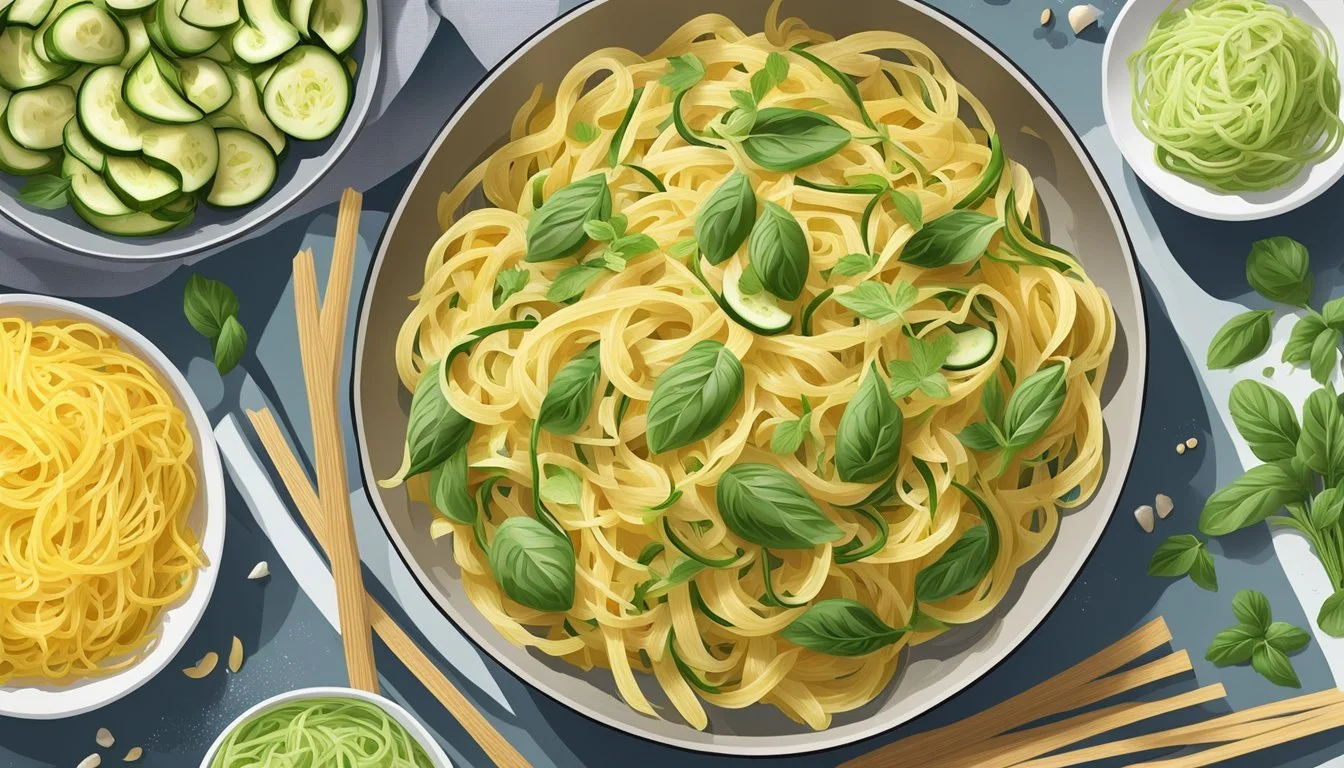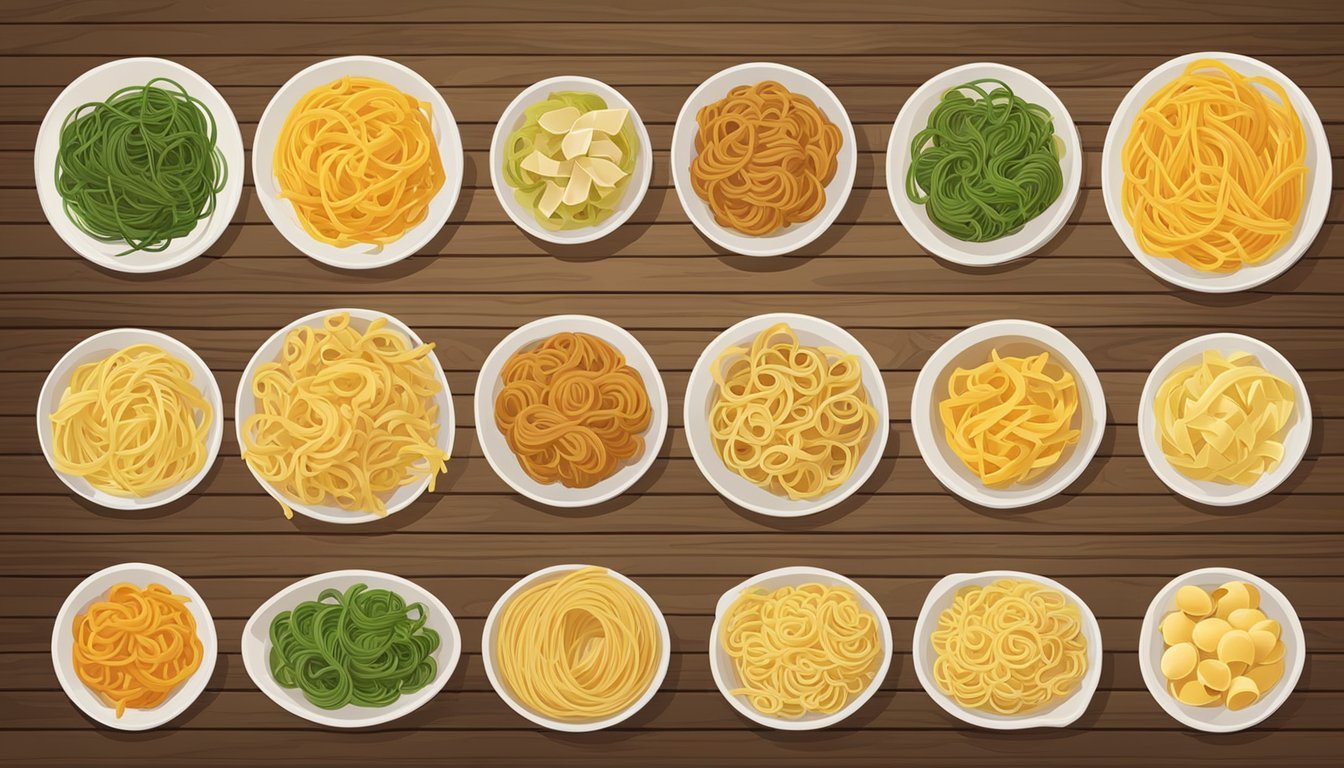Tagliolini Pasta Substitutes
Top Alternatives for Your Italian Dishes
Tagliolini, a staple of Italian cuisine, is a fine, ribbon-like pasta (What wine goes well with pasta?) that is prized for its delicate texture and ability to hold onto sauces. Originating from the regions of Piedmont and Molise, this pasta shares similarities with tagliatelle but is thinner and less wide, making it an ideal companion for light, subtle sauces often involving seafood or fine herbs. Tagliolini’s narrow, flat shape allows it to cook quickly, marrying well with the flavors it is paired with and offering a satisfying yet not overpowering presence on the palate.
For pasta enthusiasts seeking alternatives to tagliolini, several substitutes can be seamlessly incorporated into recipes calling for this specific type of noodle. Ribbon pastas such as fettuccine and tagliatelle are immediate substitutes due to their comparable shape and cooking properties. These pastas, slightly wider than tagliolini, are also egg-based and can replicate the texture and taste profile; however, the key is to adjust cooking times and sauce proportions to accommodate their differences in size.
When searching for tagliolini substitutes, it is essential to consider the pasta's role in a dish. The prime candidates will share that characteristic ribbon-like form and have a similar bite and surface area for sauces to cling to. This ensures that the integrity of the Italian dish is upheld and the dining experience remains authentic, satisfying both the discerning palate and the demands of traditional recipes.
Understanding Tagliolini Pasta
Tagliolini pasta is distinguished by its slim, ribbon-like structure, serving as a testament to its Italian origins. It's a refined variety of pasta that harmonizes well with a range of sauces, embodying the delicate craftsmanship of Tuscany.
Characteristics of Tagliolini
Tagliolini is a traditional Italian egg pasta that sits comfortably between the sizes of capellini and tagliatelle. They are recognized by:
Thickness: Typically, the strands measure between 1-3 mm in width, with some variants being slightly cylindrical.
Shape: They have a long, ribbon-like appearance that is either flat or slightly rounded.
Composition: This pasta is typically made with durum wheat flour and eggs, attributing to its tender, eggy texture.
Traditional Pairings and Sauces
The classic tagliolini is revered for its versatility in pairings:
Butter Sauces: Simple and elegant, butter-based sauces, often with a sprinkle of Parmesan cheese, complement the pasta's delicate nature.
Creamy Sauces: Tagliolini's structure allows it to cling to richer, cream-based sauces, creating a harmonious balance of texture and flavor.
Meat Ragu: Robust sauces, such as a traditional meat ragu, are absorbed by the pasta, making it an optimal choice for hearty meals.
Pesto: Ligurian-style pesto, with its bright and herby notes, enhances the lightness of the pasta for a refreshing dish.
Substitutes for Tagliolini
When looking for substitutes for Tagliolini pasta, one can consider similar pasta varieties, alternative grain pastas, or vegetable-based substitutes, offering different nutritional benefits and accommodating various dietary needs.
Similar Pasta Varieties
Fettuccine: A popular choice due to its similar flat and ribbon-like structure. Its wider shape is still suitable for clinging to sauces.
Capellini: Thinner than Tagliolini, best for light sauces. Capellini offers a delicate texture for those preferring a less hefty pasta.
Taglierini: Essentially a thinner version of Tagliolini, taglierini pairs well with light sauces such as seafood or fish due to its delicate size.
Alternative Grain Pastas
Whole Wheat Flour Pasta: An excellent option for those seeking more fiber. Whole wheat variations of fettuccine or spaghetti can provide a similar mouthfeel with added nutritional benefits.
Gluten-Free Options: Pastas made from grains like rice or quinoa (What wine goes well with quinoa?) can serve as a substitute for those with gluten intolerance, still maintaining a pleasant texture and flavor.
Vegetable-Based Substitutes
Zucchini Noodles: Zucchini can be spiralized to mimic the shape of Tagliolini, providing a low-carb and gluten-free option rich in vitamins.
Spaghetti Squash: When cooked, it separates into strands resembling pasta and pairs well with a variety of sauces while increasing your vegetable intake.
Eggplant: Thinly sliced or cut into noodle-like strands, eggplant can be a substitute to create a hearty and nutritious dish.
Preparing Pasta Alternatives
When selecting a substitute for Tagliolini pasta, it’s important to consider the cooking times and techniques as well as the sauces that best complement the alternative pasta shapes.
Cooking Times and Techniques
Each pasta alternative has its own ideal cooking time to reach the perfect al dente texture. It’s crucial to start with a large pot of boiling water, generously salted to enhance the pasta’s flavor. Here’s a brief overview of how to prepare common substitutes:
Fettuccine: Boil for 8-12 minutes.
Spaghetti: Boil for 8-10 minutes.
Angel Hair: Boil for 2-6 minutes, watching closely due to its thin nature.
Remember, these times can vary slightly based on the brand or specific product, so it’s always best to check the packaging. To avoid the pasta sticking together, stir occasionally and test for the al dente texture a minute or two before the end of the suggested cooking range.
Creating Complementary Sauces
The sauce can make or break a pasta dish. Tagliolini traditionally pairs with delicate sauces that cling to its thin strands. Here are some sauces that work well with common substitutes:
Fettuccine: Rich and creamy sauces such as Alfredo or Carbonara.
Spaghetti: Versatile enough for a hearty bolognese sauce or a simple tomato sauce.
Angel Hair: Light olive oil-based or thin tomato-based sauces to keep the dish balanced.
When creating sauces for your pasta substitute, maintain a balance between the flavors and weight of the sauce and the pasta's shape. For heavier and wider shapes like fettuccine, thicker and creamier sauces are appropriate, while lighter, thinner pastas, such as angel hair, benefit from a less robust sauce. Tailoring your sauce to the pasta ensures every bite is as enjoyable as traditional Italian cuisine intends.
Dietary Considerations
When pursuing alternatives to tagliolini pasta due to dietary restrictions, one may consider gluten-free options and those that are rich in protein yet low in carbohydrates. These substitutes can cater to diverse dietary needs while still maintaining nutritional value.
Gluten-Free Pasta Choices
For individuals with celiac disease or a gluten intolerance, gluten-free pasta options are readily available. These alternatives are often made from:
Rice flour: A staple in gluten-free cooking, providing a similar consistency to traditional pasta but with a slightly different flavor.
Quinoa: Not only is quinoa pasta gluten-free, but it also offers an additional source of protein and fiber.
Corn: Corn pasta stands out due to its bright yellow color and unique texture, contributing to an enjoyable eating experience.
These pastas can seamlessly substitute in a range of vegetarian dishes (What wine goes well with vegetarian dishes?), ensuring no compromise on taste or texture.
Protein-Rich and Low-Carb Alternatives
Those seeking to increase protein intake or decrease carbohydrates might opt for the following alternatives:
Legume-based pasta: Options such as those made from lentils, chickpeas, or black beans are high in protein and fiber, supporting a nutritious and satisfying meal.
Whole wheat pasta: While not gluten-free, whole wheat versions of pasta offer a boost in fiber and nutrients compared to traditional pasta, and are suitable for vegetarians and vegans alike.
By choosing these alternatives, diners can enjoy a balance of flavor and nutrition that supports a variety of dietary preferences and restrictions.
Regional Italian Pasta Variations
Italian cuisine exhibits a variety of pasta shapes and styles, which often embody the culinary traditions unique to each region. The following exploration highlights distinctive pasta preferences across the diverse landscape of Italy.
Northern Italy's Pasta Preferences
In Northern Italy, the varieties of pasta reflect the regions' rich culinary traditions and ingredients. Piedmont is renowned for its tagliolini, or 'tajarin' in the local dialect, which they make with a high proportion of egg yolks to achieve a rich taste and golden color. Often, it is served very thin, approximately 1mm in width, and can be enjoyed au gratin with ham and cream.
Moving to Emilia-Romagna, a region famous for its gastronomy, we find pasta types like trenette and pappardelle. Trenette, similar to the better-known linguini, is traditionally paired with pesto or seafood sauces. Pappardelle, with its broad, flat ribbons, is ideal for hearty meat sauces and is an excellent substitute for tagliatelle when creating robust dishes like Bolognese.
Southern Italy's Diverse Pasta Offerings
As we venture south, the pasta variants diversify further, reflecting the influence of different historical and agricultural factors. The Neapolitan tradition boasts mafaldine—ribbon-shaped pasta edged with ruffles, perfect for catching rich and chunky tomato-based sauces.
The lesser-known region of Molise offers gemelli, which means 'twins' in Italian. Gemelli pasta consists of two strands of pasta twisted together into a spiral shape that is adept at holding on to both lighter and more substantial sauces, demonstrating the adaptability of Southern Italy's pasta to a broad palette of regional flavors.
Conclusion
In the realm of Italian cuisine, tagliolini stands out as a pasta variety recognized for its slender, delicate profile, often served with subtle sauces to complement its fine texture. However, when tagliolini is not an option, a plethora of substitutes await to rescue any pasta dish.
For a similar mouthfeel and sauce synergy, one might consider fettuccine. Its wider surface area makes it an excellent stand-in for tagliolini, particularly when entwined with thicker, cream-based sauces. Linguine, another viable substitute, brings a slightly flatter texture to the table, yet harmonizes well with an array of sauces, from light seafood to rich pesto.
Preferred Substitute Characteristics Fettuccine Broad, flat noodles, ideal for thick sauces Linguine Flat, narrow strands, versatile in sauce pairings
It's crucial to select a pasta that not only mimics tagliolini's texture but also its cooking time and ability to bind with chosen sauces. Fettuccine, linguine, and other broad, long noodles offer this adaptability, ensuring culinary success in Italian-inspired dishes.
In summary, while tagliolini exhibits a distinct charm, its absence should not deter a home chef. They can lean on reliable alternatives like fettuccine and linguine to deliver a satisfying experience, maintaining the integrity of the Italian pasta tradition.







